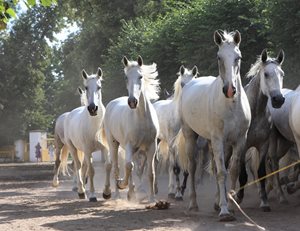The Czech Republic takes great pride in its many monuments. Some of them are so important that they have been registered on the UNESCO World Heritage List. Currently, there are 14 Czech sites on the list – the historic town centres of Český Krumlov, Telč, Prague and Kutná Hora with St Barbara’s Cathedral and the Church of the Assumption of Our Lady in Sedlec, the pilgrimage Church of St John of Nepomuk in Žďár nad Sázavou, the Lednice–Valtice Cultural Landscape Area, the village of Holašovice, the gardens and chateau in Kroměříž, the Column of the Holy Trinity in Olomouc, the Tugendhat Villa in Brno, the Jewish Quarter and St Procopius’ Basilica in Třebíč, the Litomyšl Chateau, and now also the National Stud Farm in Kladruby nad Labem and the Erzgebirge/Krušnohoří Mining Region.
National Stud Farm in Kladruby nad Labem
 The Landscape for Breeding and Training of Ceremonial Carriage Horses in Kladruby nad Labem in East Bohemia, near Pardubice, is a unique monument that documents the centuries-old breeding and training of the Kladruber horse. The Kladruby Stud Farm is also one of the oldest stud farms in the world: horses have been bred there for 500 years. Today, white Kladruber horses are still used for their original purpose by the Swedish and Danish royal courts. On 6 July 2019, the National Stud Farm in Kladruby nad Labem and the unique pastures that surround it were registered on the UNESCO list.
The Landscape for Breeding and Training of Ceremonial Carriage Horses in Kladruby nad Labem in East Bohemia, near Pardubice, is a unique monument that documents the centuries-old breeding and training of the Kladruber horse. The Kladruby Stud Farm is also one of the oldest stud farms in the world: horses have been bred there for 500 years. Today, white Kladruber horses are still used for their original purpose by the Swedish and Danish royal courts. On 6 July 2019, the National Stud Farm in Kladruby nad Labem and the unique pastures that surround it were registered on the UNESCO list.The premises of the stud farm have been kept up to date, and you can take part in several tours, both in the chateau and in the surrounding buildings. In addition, the Stud Farm organises several events for the general public every year, where you can see the Kladruber horses in action. The most notable of these include the Rudolf Cup – an international riding competition, Kladruber Horse Day in May, Kladruby naruby – an entertaining family afternoon in September, and the Hubert Ride in October.
Krušnohoří Mining Region
 The history of mining various metals greatly informed the development of the Krušné Mountains in the north of Bohemia and influenced life on both sides of the Czech and German border. Over the centuries, the technical monuments, urban compounds, and abundance of intangible heritage created a unique cultural landscape full of beautiful river valleys and scenic villages in the Krušné Mountains. Fittingly, this landscape was registered on the UNESCO World Heritage List on 6 July 2019. This important mining region includes a total of 22 locations, 5 of which are in the Czech Republic and 17 of which are in Saxony. The character of the mining cultural landscape in Křušnohoří was shaped by the extraction and processing of silver, tin, cobalt, copper, iron, and uranium over more than eight centuries, from the 12th century to the end of the 20th.
The history of mining various metals greatly informed the development of the Krušné Mountains in the north of Bohemia and influenced life on both sides of the Czech and German border. Over the centuries, the technical monuments, urban compounds, and abundance of intangible heritage created a unique cultural landscape full of beautiful river valleys and scenic villages in the Krušné Mountains. Fittingly, this landscape was registered on the UNESCO World Heritage List on 6 July 2019. This important mining region includes a total of 22 locations, 5 of which are in the Czech Republic and 17 of which are in Saxony. The character of the mining cultural landscape in Křušnohoří was shaped by the extraction and processing of silver, tin, cobalt, copper, iron, and uranium over more than eight centuries, from the 12th century to the end of the 20th.This landscape contains a long list of monuments – above-ground and underground mining facilities, metallurgical plants, and other historic remnants of the region’s mining tradition. The global impact of the Krušné Mountains on the development of mining legislation, administration, and education is indisputable, as is its influence on currency systems throughout the world, as seen in the story of the Jáchymov tolar, which developed into an all-Europe currency for more than 300 years and eventually gave rise to the term ‘dollar’. Many important inventions and innovations in mining and metallurgy were pioneered in the Krušnohoří Mining Region and then spread throughout Europe and the world, especially from the 16th century on.







-(1).jpg?width=1920&height=1204&ext=.jpg)



